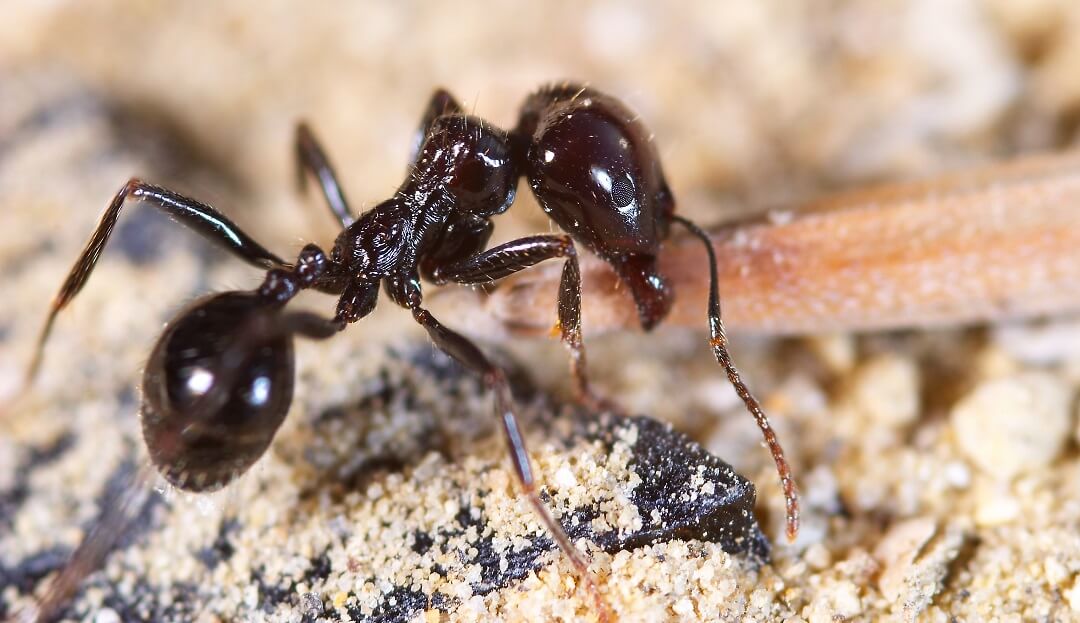
Rover ants prefer to swarm around humans. These ants haven’t always been a threat, but they’ve gotten increasingly common in recent years. They usually like to hang out in open spaces like gardens and lawns, but they will inevitably enter your home searching for food.
The dark rover ants, which are native to South America, were first publicly identified as a pest by the US pest management companies in the early 2000s. It is currently present in Georgia and all states surrounding the Gulf of Mexico and in New Mexico, Arizona, California, and southern Nevada metropolitan areas.
Key takeaways
- California has many venomous spider species.
- Insight Pest Management knows about common Southern California spiders.
- American house spiders are indoor and outdoor insect controllers.
- Western black widows are dangerous and prefer dark areas.
- Brown widows and false black widows are less venomous but still cause pain.
Physical appearance
Rover ants are small ants with adults measuring 1/12th to 1/16th of an inch in length. Their colors range from light yellow to blackish-brown. Their antennae are only 9-segmented instead of 12-segmented like most other varieties of ants. They have a hump-like thorax, and their eyes are very big compared to their head.
Ants of this species are distinguished from other members of the genus that are likely to be found in the United States by several significant characteristics. These characteristics are long hairs, a comparatively big eye, and sparseness of appressed hairs on the posterior part of the abdomen.
Distribution
Dark rover ants are native to Argentina and Paraguay and are considered to have immigrated to the United States. It was first discovered in the United States in Louisiana in 1976, although it was mistaken for another species in the same genus.
If you’re wondering where are rover ants found in America, you must know that its distribution has rapidly grown. It is now well established in Alabama, Arkansas, Florida, Georgia, Louisiana, and Mississippi and metropolitan areas in the southwest United States, including Nevada and Arizona.
Pest management professionals are noticing an upsurge in the infestations. Because they do not bite or sting, these ants have minimal economic and medicinal significance. They may, however, be a nuisance in regions where ants are not tolerated and are difficult to eradicate.
Life cycle
Like other social insects such as bees, wasps, and hornets, dark rover ants go through four life stages: egg, larval, pupae, and adult. The complete procedure might take up to 60 days from start to completion.
Habitat and host
They are present in natural and disturbed habitats, at least in the southern states. However, there is evidence that their occurrence is higher in metropolitan centers and other human activity concentrations.
Dark rover ants are typically found in mulch in agricultural environments. Nests can also be found in man-made constructions. Dark rover ants in southern California have been observed feeding on the pavement near turfs in urban areas.
The rover ants with wings create colonies through mating flights, which are most common during the summer months. Colonies are small, with hundreds or thousands of members. They only have one queen for each colony.
Diet
Rover ants prefer to feed on tree sap, plant nectars, honeydew, and other sweet liquids. If you find them inside your homes, they will feed on crumbs and juices and other sweet-tasting liquids found on counters and floors.
How to treat and control rover ants
When these ants get close to a house, they inspect every inch of the foundation for possible access sites. Although they do not bite or sting, this ant species may be rather bothersome. Here are methods for how to get rid of rover ants:
1. Seal entrances
Fill up any gaps or cracks around your home. Check the condition of the screens and weatherstripping. Examine your foundation walls carefully, paying specific attention to pipes, wire conduit, and other things that pass through.
2. Maintain yard
Trees and bushes should be pruned so that they do not touch the side of your house. Regularly mow your yard. Make sure your gutters are clean and functional.
3. Move away moist and rotting wood.
Rover ant infestations are frequently linked to dampness. Preventing an infestation by repairing water leaks in your house and yard. Any water-damaged timber should be replaced. Remove any standing water both indoors and outside.
4. Use a dehumidifier, especially in basements.
If rover ants have infested your basement, dehumidifiers and fans can lower humidity and moisture levels sufficiently to make your home unattractive to these insects.
5. Chemical treatments
It is not recommended that pesticides be used to manage these insects. Chemicals do not methodically treat the issue and can be hazardous to humans and pets.
6. Natural treatments/detterents.
Some natural ways to get rid of dark rover ants include baits, insect sprays, or insecticide dust. To achieve an acceptable measure of control, chemical products may be required. The use of insecticides to target and treat nests, and perimeter treatments, will be beneficial. Gel baits and dusts can be put in electrical outlets for interior control, and aerosols work well in wall voids.
Keep yourself safe from dark rover ants
Rover ants are among the most challenging to manage insects. Many liquids or granular ant bait compositions do not appear to attract them. Rover ant removal is a complex job that is best left to a residential pest control service.
If you find rover ants in your house or office, request an appointment with Insight Pest for quick treatment. Our experts can help you remove rover ants and keep them out by providing inexpensive and efficient ant control solutions.

